Mitral Valve Disease Breeding Protocol
for the Cavalier King Charles Spaniel
-
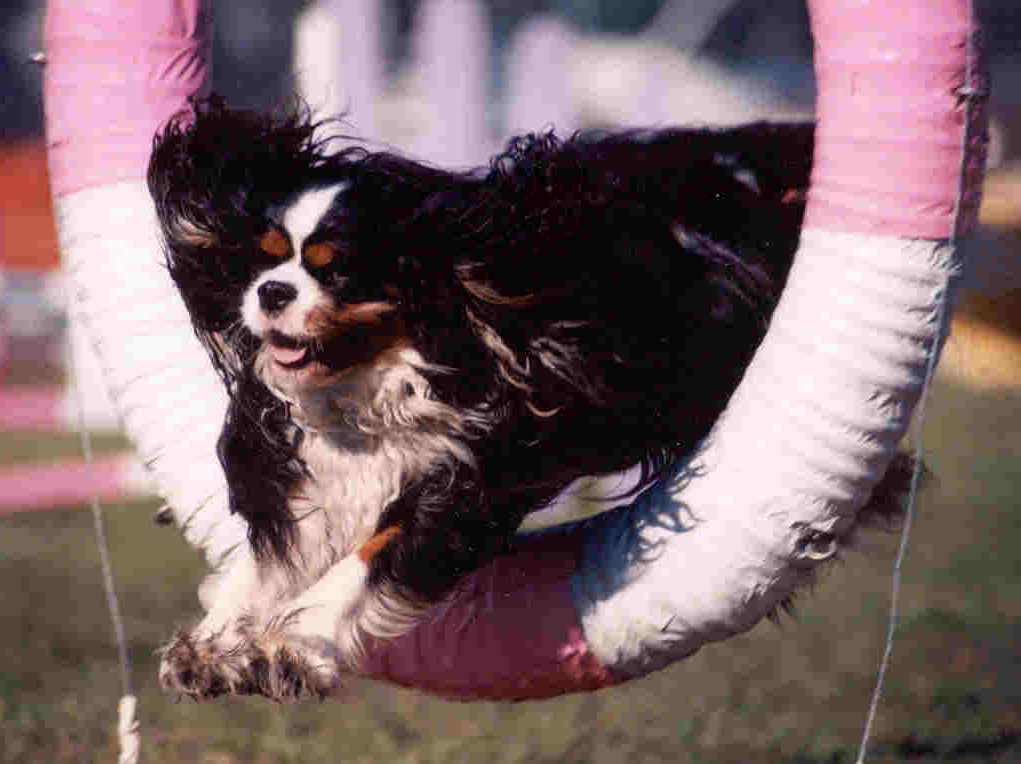 MVD
Breeding Protocol
MVD
Breeding Protocol - In Depth
- -- history of the protocol
- -- since the 1998 symposium
- --- US cavalier clubs
- --- UK cavalier club
- --- Canada cavalier club
- --- Swedish clubs
- --- Dutch clubs
- --- Danish clubs
- --- Finnish cavalier club
- --- French cavalier club
- --- Flemish (Belgium) Breeding Commission
- -- cavalier breeders' objections
- Research News
- Related Links
- Veterinary Resources
If a mitral valve murmur is detected before the cavalier's fifth birthday, that dog's mitral valve disease (MVD) is defined as "early-onset". Early-onset MVD has been found to be "highly heritable" in the cavalier King Charles spaniel breed, and "selection against the disease should be successful.", according to an April 2011 research report.
Veterinary specialists have designed breeding guidelines to eliminate early-onset mitral valve disease in Cavalier King Charles spaniels in the United States and the United Kingdom. The guidelines (called the MVD Breeding Protocol) were strongly advised to US breeders in 1998 (and in 1996 to UK CKCS breeders) by a group of veterinary cardiologists and a geneticist who had dedicated years of study to mitral valve disease in Cavaliers.*
*In other countries, veterinary cardiologists and geneticists have designed similar breeding guidelines, either by auscultation (listening to the flow of blood through the mitral valve using a stethoscope), as in Canada and Sweden, or by echocardiograph (ultrasound) scanning, as in France.
Both the UK's Cavalier King Charles Spaniel Club and the Cavalier King Charles Spaniel Club of Canada have endorsed the MVD Breeding Protocol.* In 2001, the Swedish Kennel Club introduced a modified, but mandatory version of the MVD Breeding Protocol for all cavaliers, and in 2011, the Dutch Kennel Club introduced its own mandatory, modified version of the MVD Breeding Protocol for all CKCSs being bred. The Cavalier King Charles Spaniel Club, USA endorsed the full MVD protocol from 1998 to 2010, when the leadership of that club decided to replace the protocol with a fictitious, watered-down version which no panel of veterinary cardiologists has ever recommended and is destined to fail.
*However, neither the UK CKCS club nor the Canada CKCS club requires that the dogs be examined by veterinary cardiologists.
Since 1998, only an insignificant minority of breeders of Cavalier King Charles spaniels in the United States have followed these guidelines. In the 19 years since then, the vast majority of such breeders have squandered at least five generations (at 2.5 years per generation) of Cavaliers towards eliminating early-onset (onset before age 5 years) mitral valve disease.* By shunning the MVD Protocol and actually increasing the breedings of Cavaliers in violation of the MVD Protocol, the great majority of American breeders have acted irresponsibly and in callous disregard for the health and welfare of future generations of Cavaliers.
*For example, in 2010, 55% of all cavalier litters registered with the UK Kennel Club had at least one parent under the age of 2.5 years.
The MVD Breeding Protocol
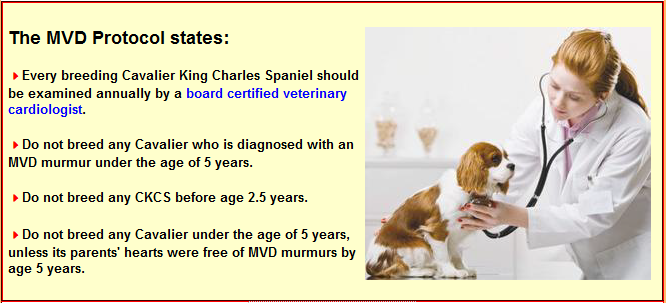
RETURN TO TOP
In Depth
-- history of the protocol
The MVD Breeding Protocol has been designed to eliminate early-onset mitral valve disease. Veterinary cardiologists throughout North America and Europe conducted studies of MVD in Cavaliers in the 1990s.
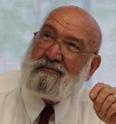
 A group of four world renowned veterinary cardiologists, Doctors Andrew Beardow from England,
James
Buchanan (right) from the United States, Virginia Luis Fuentes from Scotland, and
Bruce Keene (left) from the US, and an internationally respected
geneticist, Professor Lennart Swenson from Sweden, each
presented reports on the results of their professional studies about the
disease in 1998 (to the CKCSC,USA). Their conclusions:
A group of four world renowned veterinary cardiologists, Doctors Andrew Beardow from England,
James
Buchanan (right) from the United States, Virginia Luis Fuentes from Scotland, and
Bruce Keene (left) from the US, and an internationally respected
geneticist, Professor Lennart Swenson from Sweden, each
presented reports on the results of their professional studies about the
disease in 1998 (to the CKCSC,USA). Their conclusions:
• MVD is the leading cause of death in cavaliers;
• It is a hereditary, genetic disorder;
• There has been no statistical improvement in cavaliers' mitral valves in the eleven years since the first studies; and
• The disease can be decreased and the age of onset delayed by following guidelines of only breeding cavaliers who are over the age of 2.5 years, have hearts free from MVD murmurs, and have parents whose hearts were MVD murmur-free at age 5 years. No cavaliers should be bred which have murmurs before age 5 years.
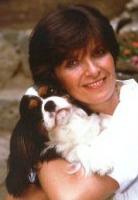 These experts presented their findings and conclusions at
a symposium in
May 1998, which was sponsored by the Cavalier King Charles Spaniel Club,
U.S.A. (CKCSC,USA).* Under the leadership of its then president, C. Anne
Eckersley-Robins (left), the board of directors of the CKCSC,USA then also endorsed
the MVD Breeding Protocol in 1998.
These experts presented their findings and conclusions at
a symposium in
May 1998, which was sponsored by the Cavalier King Charles Spaniel Club,
U.S.A. (CKCSC,USA).* Under the leadership of its then president, C. Anne
Eckersley-Robins (left), the board of directors of the CKCSC,USA then also endorsed
the MVD Breeding Protocol in 1998.
* A similar presentation was made in November 1996 before the UK Cavalier King Charles Spaniel Club.
 These guidelines were developed by the Swedish Kennel Club, and are based
upon that club's successful efforts to reduce hip dysplasia in Rottweilers.
Between 1976 and 1994, the percentage of Rottweilers diagnosed with hip
dysplasia decreased from 36% to 11% by following a similar breeding program.
Professor Swenson (right) reported that hip dysplasia is a multifactorial, polygenic
trait, and it is believed MVD is also.
These guidelines were developed by the Swedish Kennel Club, and are based
upon that club's successful efforts to reduce hip dysplasia in Rottweilers.
Between 1976 and 1994, the percentage of Rottweilers diagnosed with hip
dysplasia decreased from 36% to 11% by following a similar breeding program.
Professor Swenson (right) reported that hip dysplasia is a multifactorial, polygenic
trait, and it is believed MVD is also.
He pointed out that it is not realistic to expect to eliminate the causes of mitral valve disease by any breeding program without further research into the reason for the high prevalence of the disorder in cavaliers. Instead, the goal is to postpone the onset of the disease so that all cavaliers die a natural death before MVD becomes a health problem.
Professor Swenson believes that if the recommended breeding guidelines
are followed by all breeders, we would see improvement after the first
generation and significant progress towards delaying the onset of MVD over
two to three generations. Mitral valve disease is not controlled by a single
gene, but there may be one d ominant gene which controls the worst (earliest
onset) 30% of MVD cases. He stated that if that is correct, this worst gene
would be the first one to disappear once the breeding guidelines are
universally followed.
ominant gene which controls the worst (earliest
onset) 30% of MVD cases. He stated that if that is correct, this worst gene
would be the first one to disappear once the breeding guidelines are
universally followed.
Dr. Luis Fuentes (right) reported on the British studies, which began in 1987 and showed that 50% of all 5 year old cavaliers had MVD murmurs, and all examined Cavaliers over the age of 10 had murmurs. The English Cavalier King Charles Spaniel Club has endorsed the Swedish guidelines, and it also is publishing a registry of all cavaliers over age 5 years with murmur-free hearts.
 Dr. Beardow
(left) explained that the guidelines call for each breeding cavalier
to be examined annually by a veterinary cardiologist using a stethoscope. He
said that, compared to an echocardiographic examination, the use of a
stethoscope (called auscultation) by a cardiologist is 90% accurate in
detecting MVD. In view of the relative wide availability and low cost of
auscultation diagnosis, it is preferred over more expensive alternatives.
Compliance with the guidelines is enhanced by using relatively inexpensive,
simple, and effective measuring methods. Also, the speakers expressed their
concern that the testing device be specific enough to identify MVD but not
so sensitive as to eliminate all of the breeding stock.
Dr. Beardow
(left) explained that the guidelines call for each breeding cavalier
to be examined annually by a veterinary cardiologist using a stethoscope. He
said that, compared to an echocardiographic examination, the use of a
stethoscope (called auscultation) by a cardiologist is 90% accurate in
detecting MVD. In view of the relative wide availability and low cost of
auscultation diagnosis, it is preferred over more expensive alternatives.
Compliance with the guidelines is enhanced by using relatively inexpensive,
simple, and effective measuring methods. Also, the speakers expressed their
concern that the testing device be specific enough to identify MVD but not
so sensitive as to eliminate all of the breeding stock.
Most importantly, the experts emphasized that, to be effective, the breeding guidelines must be widely supported and uniformly implemented. The biggest reason that breeding guidelines fail is that the breeders do not follow them. Therefore, the results of the tests should be published for all to see. The English Cavalier Club's registry of murmur-free dogs is aimed at encouraging breeders to follow the guidelines.
A printable transcript of the May 1998 MVD symposium proceedings is available here.
RETURN TO TOP
-- since the 1998 symposium
--- United States cavalier clubs
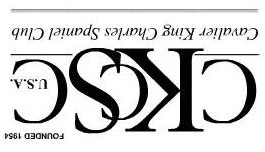 The board of directors of the Cavalier King Charles Spaniel Club,
USA (CKCSC,USA) promptly endorsed the MVD Breeding Protocol as
recommended guidelines in May 1998, the same weekend that the MVD symposium
was presented to its club members. The club also started a registry of all
cavaliers which were certified to have been murmur-free over the age of five
years, called the CKCSC,USA Health Registry. However, in 2002, the CKCSC,USA
began ignoring the protocol, including removing it from the club's Internet
website and firing its Health Registry secretary. In 2010, the CKCSC,USA's
board pretended that it had never endorsed the protocol in 1998 and approved
a set of worthless breeding guidelines which no cardiologist
The board of directors of the Cavalier King Charles Spaniel Club,
USA (CKCSC,USA) promptly endorsed the MVD Breeding Protocol as
recommended guidelines in May 1998, the same weekend that the MVD symposium
was presented to its club members. The club also started a registry of all
cavaliers which were certified to have been murmur-free over the age of five
years, called the CKCSC,USA Health Registry. However, in 2002, the CKCSC,USA
began ignoring the protocol, including removing it from the club's Internet
website and firing its Health Registry secretary. In 2010, the CKCSC,USA's
board pretended that it had never endorsed the protocol in 1998 and approved
a set of worthless breeding guidelines which no cardiologist
 researchers had
ever suggested would be effective. See
here for details.
researchers had
ever suggested would be effective. See
here for details.
The American Cavalier King Charles Spaniel Club (ACKCSC), which is the cavaliers' parent club in the American Kennel Club (AKC) has never acknowledged the existence of the MVD Breeding Protocol. See here for details.
RETURN TO TOP
--- CKCSC of UK
New 2018 Heart Scheme
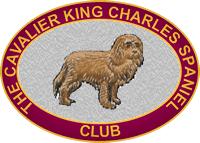 In
2018, the UK Kennel Club began the “Kennel Club Heart Scheme for
Cavalier King Charles Spaniels”, which is a major modification of the
MVD Breeding Protocol first introduced in the UK in 1996. It is not
mandatory but is recommended that all CKCS breeders follow it to “lower
the risk of producing [MVD-]affected puppies.”
In
2018, the UK Kennel Club began the “Kennel Club Heart Scheme for
Cavalier King Charles Spaniels”, which is a major modification of the
MVD Breeding Protocol first introduced in the UK in 1996. It is not
mandatory but is recommended that all CKCS breeders follow it to “lower
the risk of producing [MVD-]affected puppies.”
The new scheme involves cardiologists examining the cavaliers intended to be bred should be examined by a cardiologist by stethoscope (auscultation) to determine if they have a mitral valve murmur, and by echocardiograph (Doppler), to determine if they have mitral valve prolapse and to confirm whether the murmur is in fact from the mitral valve. See this UK Kennel Club webpage for the details.
Mitral valve murmurs are graded from 0 to 6, with 0 indicating no murmur and 6 indicating the most severe murmur. Mitral valve prolapse (MVP) will be graded 0 to 3, as follows:
• 0 – none
• 1 – mild
• 2 – moderate
• 3 – severe
During the echo, the cardiologist also records other measurements of the heart chambers for future reference and research purposes. If the dogs are still being used for breeding, follow-up examinations are to be conducted at ages 4 and 6 years. The cardiologists will issue “test certificates” showing the results of the examinations. Those certificates will expire after two years unless renewed by the follow-up exams.
The dogs’ grades are recorded on the Kennel Club’s database and are published in one or more of the following: the Breed Records Supplement, on the registration certificate, the Kennel Club website (Health Test Results Finder and Health Pages).
How it is supposed to work:
GREEN BOXES: “These dogs have the lowest risk of developing clinical MVD and the lowest risk of passing the condition on to any offspring.”
AMBER BOXES: “These dogs have a higher risk of developing and/or passing on the condition to offspring. Only amber dogs that are in excellent health, and have good results from other screening schemes, may be used cautiously for breeding, and only with a mate categorised as green, preferably at four years of age or older.”
RED BOXES: “These dogs have the greatest risk of passing the condition to offspring and so should not be used for breeding.”
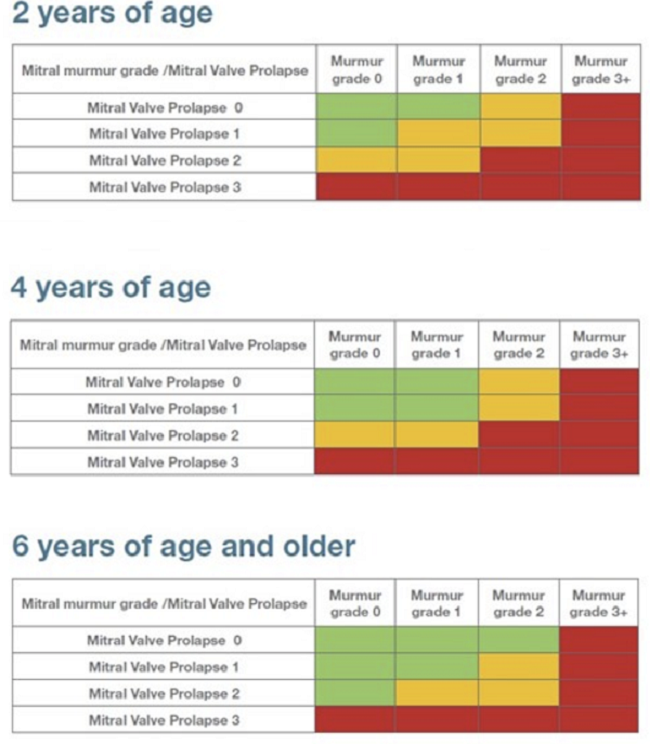
The UK Kennel Club announced in its 2021-2022 Annual Report, issued in November 2022, that:
""Over 700 Cavalier King Charles Spaniel Heart Scheme assessments have been undertaken to date, and over the last year we saw a 47% increase."
Pre-2018 History
The United Kingdom CKCS club's version of the MVD Breeding Protocol does not require that veterinary cardiologists perform the stethoscopic examinations for heart murmurs, although it does require that cavaliers over the age of five years be examined by cardiologists in order to qualify for inclusion on the club's "Over Five" list.
Since the 1998 report, studies conducted by veterinary heart and genetic specialists have confirmed the efficacy of the MVD Breeding Protocol. In a 2000 research study of 4,255 CKCS heart examinations, Dr. James Wood of the Animal Health Trust in the United Kingdom reported that:
• MVD is the major killer of cavaliers under 10 years of age.
• Veterinary cardiologists were better able to identify early mitral valve murmurs than were non-specialist veterinarians.
• The parent's heart status can predict the offspring's future heart status.
• The offspring were ten to twenty times more likely to be free of MVD murmurs if the sire's heart was clear of murmurs at ages nine to eleven years.
In a 2009 report by UK veterinary cardiologist Simon Swift to the UK's Cavalier Club, he stated that 50% of cavaliers still are developing MVD murmurs by their fifth birthday. This is because most breeders are not following the MVD breeding protocol. At the November 2010 "Cavalier Health Day", sponsored by the UK Cavalier Club, Mr. Swift reiterated the importance of breeders following the MVD breeding protocol. He told the assembled breeders that the protocol was "rigorous advice that should be properly followed."
In an October 2016 statement, cardiologist Swift wrote:
"Examining dogs on the database for the period between 2006 and 2010 showed only four per cent of dogs had followed this breeding advice -- that is, had parents or grandparents tested clear older than five years."
In a January 2017 article, researchers reviewed the records of 8,860 UK cavaliers from 1991 through 2010. The records were reported by veterinarians on dogs presented voluntarily by breeders at CKCS club conformation shows or to their local veterinary practices and relied upon completed forms being returned to the central database. Therefore, the researchers report, some younger dogs with murmurs detected by their local veterinarians may not have been presented at shows, or their forms not returned if a murmur was detected. The results:
• 16,887 examinations were performed on 8,860 cavaliers to detect mitral valve disease (MVD) murmurs.
• Males developed murmurs earlier than females -- median age difference was 0.5 years.
• Cardiologists detected murmurs in younger dogs compared to general practice (GP) veterinarians with a difference in the median age of 1.4 years.
• The age incidence of MVD murmurs might be increased if breeders followed the MVD breeding guidelines.
• Compliance of UK breeders with this voluntary scheme has been poor. Only 4% of cavalier breeders in the UK CKCS club have followed the MVD breeding protocol.
As recently as 2009, the chairman of the UK's Cavalier King Charles Spaniel Club stated: "There are many members who are still not prepared to health check their breeding stock, and of those who do, it would appear that many would not hesitate to breed from affected animals."
In a November 2016 press release, the UK Kennel Club announced that it has approved a health testing scheme for cavalier King Charles spaniels, with the intended result of "dramatically" improving the heart health of the CKCS. Apparently, the move was motivated by the January 2016 article reporting on Denmark's mandatory testing policy. The UK program will consist of veterinary cardiologists examining cavaliers to determine if each dog has a mitral valve murmur. An echocardiograph scan also will be performed and sent to Dr. Lisbeth Høier Olsen in Denmark, for her to measure the heart. Each dog will be issued a certificate from the University of Copenhagen, with both a murmur and mitral valve prolapse score. The Kennel Club will record the certificate results on the dog's registration record and made available publicly. The Kennel Club also intends to update MVD breeding recommendations for cavaliers.
In an April 2017 article by Cavaliers Are Special, the breeding and health testing records of 114 top points-winning UK cavalier King Charles spaniels are analyzed to determine their breeders' compliance with the UK cavalier club's MVD Breeding Protocol. The results:
"From 2012 to 2016 inclusive these prize-winning Cavaliers produced 755 litters. Of these, 345 (46%) were bred by the Club Committee/Puppy Coordinator group. There were 229 litters with one or both parents under 2.5 years (30%). Of the 345 litters, 135 bred by the Club Committee/Puppy Coordinator group (39%) had one or both parents under 2.5. Non-compliance with age guidelines with breeders outside this group was 23% (94 of 410 litters)."
In a statement included in a DogWorld.co.uk article published in April 2017, UK Kennel Club secretary Caroline Kisko announced that the Kennel Club rejects the MVD Breeding Protocol because it requires "breeding from older bitches." The protocol, which was introduced in the UK in 1996 and has been endorsed by the UK Cavalier Club, calls for not breeding any cavalier until they reach the age of 2.5 years. Ms. Kisko in effect ridiculed the protocol by declaring that 2.5 year old CKCS dams are "older bitches".
In a May 2018 press release, the The UK Kennel Club and the UK Veterinary Cardiovascular Society announced on May 21, 2018 that they had developed the new MVD breeding scheme for cavalier King Charles spaniels. Application of the breed scheme began with a trial of 100 dogs, and later in 2018 it became available to all cavalier breeders and owners.
RETURN TO TOP
--- CKCSC of Canada
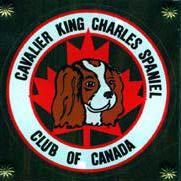 On the bright side, since 2011, the Canadian cavalier club has endorsed the MVD breeding
protocol. On
its
website, it states:
On the bright side, since 2011, the Canadian cavalier club has endorsed the MVD breeding
protocol. On
its
website, it states:
"The Cavalier King Charles Spaniel Club Of Canada has recently included the recommendation within its Breeders' Guidelines that Breeders breed Cavalier King Charles Spaniels that are at least 2.5 years old and murmur-free that have parents that were murmur-free at age 5 years."
However, the Canadian club's version of the MVD Breeding Protocol does not require that veterinary cardiologists perform the stethoscopic examinations for heart murmurs.
RETURN TO TOP
--- Swedish Kennel Club
 The Swedish Kennel Club and
(SKK) the Swedish Cavalier King Charles Spaniel
Club (Cavaliersällskapet) follow a mandatory modified version of the MVD Breeding Protocol. In
Sweden, to be eligible for breeding, all cavaliers must be tested clear of
MVD murmurs at age 36 months, and their parents must have been tested clear
of MVD murmurs at age 60 months. Male cavaliers may produce no more than 5
litters between ages 3 and 6 years, and after age 6 years, they are free to
breed if their hearts are murmur-free.
This breeding protocol
took effect in January 2017 and is a tougher revision of a mandatory
protocol begun in 2001.
The Swedish Kennel Club and
(SKK) the Swedish Cavalier King Charles Spaniel
Club (Cavaliersällskapet) follow a mandatory modified version of the MVD Breeding Protocol. In
Sweden, to be eligible for breeding, all cavaliers must be tested clear of
MVD murmurs at age 36 months, and their parents must have been tested clear
of MVD murmurs at age 60 months. Male cavaliers may produce no more than 5
litters between ages 3 and 6 years, and after age 6 years, they are free to
breed if their hearts are murmur-free.
This breeding protocol
took effect in January 2017 and is a tougher revision of a mandatory
protocol begun in 2001.
Older males which were murmur-free at age 8 years may continue to breed even if they develop MVD-murmurs afterwards. This is a change from the 7 year cut off prior to 2017. This is an unfortunate aspect of the SKK protocol, because the year's difference will have the effect of reducing the gene pool of CKCSs which clearly do not have early-onset MVD.
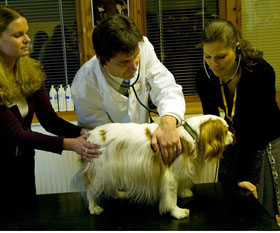 The
Swedish clubs do not require that all stethoscopic examinations of the
cavaliers' hearts be performed by veterinary cardiologists, which is a
requirement of the MVD Breeding Protocol. However, all Swedish veterinarians
who are licensed to issue clear-heart certificates for this registry must
pass an auscultation examination conducted by Sweden's top
cardiologists/researchers, Drs. Jens Häggström (left)
and Clarence Kvart
(below).
The
Swedish clubs do not require that all stethoscopic examinations of the
cavaliers' hearts be performed by veterinary cardiologists, which is a
requirement of the MVD Breeding Protocol. However, all Swedish veterinarians
who are licensed to issue clear-heart certificates for this registry must
pass an auscultation examination conducted by Sweden's top
cardiologists/researchers, Drs. Jens Häggström (left)
and Clarence Kvart
(below).
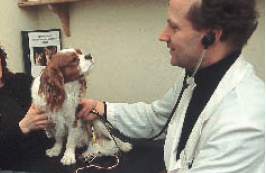 In a
2010 study
by cardiologist Dr. Clarence Kvart
of the mandatory Swedish CKCS club breeding protocol, Dr. Kvart reports that that
the prevalence of MVD in six-year-old cavalier King Charles spaniels, born
2001 and 2003, is at least 50% and lacks signs of decrease despite the
current breeding program introduced in Sweden 2001. The Swedish clubs
have declined to toughen their program to match Prof.
Swenson's recommendation.
In a
2010 study
by cardiologist Dr. Clarence Kvart
of the mandatory Swedish CKCS club breeding protocol, Dr. Kvart reports that that
the prevalence of MVD in six-year-old cavalier King Charles spaniels, born
2001 and 2003, is at least 50% and lacks signs of decrease despite the
current breeding program introduced in Sweden 2001. The Swedish clubs
have declined to toughen their program to match Prof.
Swenson's recommendation.
Nevertheless, in 2013, the Swedish Kennel Club reported that of 988 cavaliers tested in 2012 for mitral valve disease, only six under the age of four years had murmurs, and only 61 of all of them had murmurs.
By way of comparison, a pair of September 2005 studies [1] [2] of Swedish cavaliers from 1995 to 2000 showed that 23% were dead by eight years, and 48% were dead by ten years. Those researchers stated:
"Heart disease in the Cavalier King Charles spaniel accounts for over 50% of deaths in that breed (in dogs under 10 years of age) and for over one-quarter of the heart deaths in the insured population [of all breeds]. Although heart disease in Cavalier King Charles spaniels is well recognized, these statistics give further insight into the impact of this cause of death in this breed."
RETURN TO TOP
--- Dutch Kennel Club
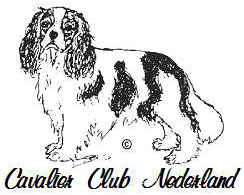 Since
2011, the Dutch cavalier King Charles spaniel club (Cavalier Club Nederland)
and the
Dutch Kennel club also have been following a mandatory modified
version of the MVD breeding protocol. In theirs, all breeding stock
cavaliers must have their hearts examined by ultrasound at age one year or
prior to breeding. Thereafter, their hearts must be re-examined by
auscultation by a specialist. If a mitral valve murmur is detected before
the dog's fifth birthday, it may not be bred.
Since
2011, the Dutch cavalier King Charles spaniel club (Cavalier Club Nederland)
and the
Dutch Kennel club also have been following a mandatory modified
version of the MVD breeding protocol. In theirs, all breeding stock
cavaliers must have their hearts examined by ultrasound at age one year or
prior to breeding. Thereafter, their hearts must be re-examined by
auscultation by a specialist. If a mitral valve murmur is detected before
the dog's fifth birthday, it may not be bred.
RETURN TO TOP
--- Danish Cavalier Club
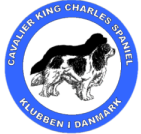 The
Cavalier King Charles Spaniel Club of Denmark (Cavalierklubben), and the
Danish (Dansk) Kennel Club
(DDK), have had a mandatory MVD breeding protocol, using
both auscultation and ultrasound, since 2002. The protocol is a
modification of the standard MVD protocol. Currently, through May 2017,
the male and female breeding dogs first must be examined by auscultation
and echocardiograph at the age of 18 months or later by veterinarians
approved by the Danish Kennel Club. If a dog is found to be clear of
MVD, it is issued a breeding certificate which is valid until the dog
reaches the age of 4 years and a month. If the dog is to be bred after
that age, it must be re-examined, found clear of MVD, and receive
another certificate, which, for females, is valid for life. For males,
the second certificate is valid until age 6 years and a month. If the
male is to be bred after that age, he must be examined and ceritifed a
third time.
The
Cavalier King Charles Spaniel Club of Denmark (Cavalierklubben), and the
Danish (Dansk) Kennel Club
(DDK), have had a mandatory MVD breeding protocol, using
both auscultation and ultrasound, since 2002. The protocol is a
modification of the standard MVD protocol. Currently, through May 2017,
the male and female breeding dogs first must be examined by auscultation
and echocardiograph at the age of 18 months or later by veterinarians
approved by the Danish Kennel Club. If a dog is found to be clear of
MVD, it is issued a breeding certificate which is valid until the dog
reaches the age of 4 years and a month. If the dog is to be bred after
that age, it must be re-examined, found clear of MVD, and receive
another certificate, which, for females, is valid for life. For males,
the second certificate is valid until age 6 years and a month. If the
male is to be bred after that age, he must be examined and ceritifed a
third time.
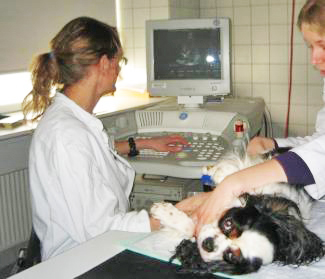 In a
June 2013 report to the clubs and to the ACVIM, Dr. Lisbeth Høier
Olsen (right) stated that in 2011, 997 Danish CKCSs were examined under the
Danish Kennel Club's mandatory breeding program during the period from
2002 to 2011. Each dog was evaluated from one to four times for a total
of 1,380 examinations by auscultation and echocardiography. The study
found that the risk of having MVD in 2010-2011 was compared to the
period 2002-2003 for cavaliers which were the offspring of parents in
the mandatory breeding protocol and those which were not (such as
imported cavaliers). In 2010-2011, the examined dogs within the club's
breeding protocol had a 71% reduced risk of having MVD than dogs in
2002-2003. As for offspring of parents not subject to the breeding
protocol, the reduced risk of having MVD did not reach statistical
significance.
In a
June 2013 report to the clubs and to the ACVIM, Dr. Lisbeth Høier
Olsen (right) stated that in 2011, 997 Danish CKCSs were examined under the
Danish Kennel Club's mandatory breeding program during the period from
2002 to 2011. Each dog was evaluated from one to four times for a total
of 1,380 examinations by auscultation and echocardiography. The study
found that the risk of having MVD in 2010-2011 was compared to the
period 2002-2003 for cavaliers which were the offspring of parents in
the mandatory breeding protocol and those which were not (such as
imported cavaliers). In 2010-2011, the examined dogs within the club's
breeding protocol had a 71% reduced risk of having MVD than dogs in
2002-2003. As for offspring of parents not subject to the breeding
protocol, the reduced risk of having MVD did not reach statistical
significance.
Comparing the Swedish and UK cavalier breeding protocols with those of Denmark, Dr. Olsen stated:
"The Danish breeding program (mandatory, auscultation and heart scan at 1½, 4 and dogs 6 years) seems more effective than the English and Swedish (only auscultation, but every year, and the inclusion of parents animal cardiac status). The Swedish program is mandatory while the UK voluntarily ."
At a meeting of the Euoropean Society of Veterinary Cardiology in September 2014, Dr. Olsen and Jens Häggström and Simon Swift presented a written summary of their evaluations of the three breeding programs. They said that their conclusions will be published in a scientific paper in 2015. Based upon that input, the DKK ordered that, beginning in June 2015, the mandatory cavalier breeding protocol continue through May 2017. The DKK stated that, if in the course of this two-year period any new studies demonstrate the same or better effect of simpler or cheaper breeding programs, the DKK and the Danish cavalier club can enter into dialogue about whether the current breeding protocol be changed.
In a January 2016 article, Drs. Olsen's and Häggström's team of Danish and Swedish cardiologists (A.C. Birkegård, M.J. Reimann, T. Martinussen, J. Häggström, H.D. Pedersen, L.H. Olsen) reported that the Danish Kennel Club's 2001 mandatory MVD breeding scheme has reduced the risk of having a mitral regurgitation murmur caused by MMVD by 73% among 997 cavalier King Charles spaniels. They re-stated Denmark's MVD breeding guidelines as:
1. Dogs examined at 1½ years of age or older were approved for breeding until 4 years of age if cardiac health criteria were fulfilled.
2. To continue breeding after 4 years of age, the dogs had to be reexamined. In January 2007, an additional restriction was added, requiring a reexamination after 6 years of age for male dogs.
3. At all examination time points, dogs were excluded from breeding if they had MVP (mitral valve prolapse by echocardiograph) grade 3 or a mitral regurgitation murmur grade 3 or higher.
MVP grades were as follows:0: ≤1.5 mm (as the sum of the maximum protrusion of the cranial, caudal and coaption point of the mitral valve according to annulus plane)4. Dogs with grade 2 murmurs were excluded if they had MVP grades 2 or 3.
1: >1.5 and ≤4.5 mm
2: >4.5 and ≤7.5 mm
3: >7.5 mm
Thus, cardiac health criteria for breeding in the MMVD breeding scheme of the DKCA were as follows:
• Mitral regurgitation murmur of 1 at a maximum combined with a MVP grade 2 at a maximum; or
• Grade 2 murmur combined with a degree of MVP not above 1.
Before 2007, dogs with a grade 3 MVP were approved if they had a murmur grade not above 1.
The researchers concluded:
"Our study shows that a breeding scheme based on cardiac auscultation and echocardiography markedly decreased the risk of having a mitral regurgitation murmur caused by MMVD after an 8- to 10-year period. The reduction in risk was only significant for offspring where both parents had been approved by the breeding scheme (PB), not for offspring where 1 or both parents not were approved by the breeding scheme (non-PB). The risk of having moderate to severe MVP (MVP > 1) was not decreased after the 8- to 10-year period, but PB had lower risk of MVP > 1 than did non-PB within the years 2010 and 2011. ... A mandatory breeding scheme based on auscultation and echocardiography findings significantly decreased the prevalence of MMVD over the 8- to 10-year period. Such a breeding scheme therefore is recommended for CKCS."
In a February 2024 article, Danish researchers reported that Denmark's MVD breeding restrictions have reduced early-onset MVD prevalance, excluding only 5% from breeding. They compared the mitral valve measurements of the left atrium and left ventricle and murmur grade of 55 cavalier King Charles spaniels which also had been MRI scanned and diagnosed with or without syringmyelia (SM). Of the 55 CKCSs, 22 had symptomatic SM, 18 had asymptomatic SM, and 15 had no SM. Of the 55 cavaliers, 13 had no MVD signs, 32 were diagnosed with MVD Stage B1, 7 with Stage B2, and 3 with Stage C. Most significantly, they stated that, in Denmark, MVD breeding restrictions issued by the Danish Kennel Club, assessing mitral regurgitation murmurs and mitral valve prolapse severities have proven to effectively reduce the prevalence of early-onset MVD in CKCS, excluding only approximately 5% from breeding. Therefore, one of the investigators' motivations was a concern that those Danish breeding restrictions could potentially influence the prevalence of SM. The secondary aim of the study was to investigate the severity of MVD in SM-affected cavaliers with and without clinical signs of SM. The investigators report finding no significant difference in left atrial (LA) and left ventricle (LV) measurements between CKCSs with or without SM. However, they did find that CKCS with symptomatic SM had "significantly smaller" LA and LV dimensions, compared to those with asymptomatic SM and those without SM.
The Dansk (Danish) Kennel Club (DKK) announced that as of January 1, 2025 it has opened its Stud Book to admit unregistered cavalier King Charles spaniels, "as a positive contribution to the development of the breed and ensuring genetic variation in the breed." This means that cavaliers in Denmark without FCI pedigreea that have an approved mitral valve (MVD) examination can be registered in the DKK. The procedure to determine eligibility is:
• Have the dog's heart examined for MVD by a specially trained cardiologist.
• The dog must be at least 18 months old.
• The dog must be healthy and pass the DKK's MVD grading tests for mitral regurgitation murmurs and mitral valve prolapse by echocardiography.
If the dog passes that MVD test, then the dog is to be physically examined by a DKK judge to assess if the dog is "breed typical".
RETURN TO TOP
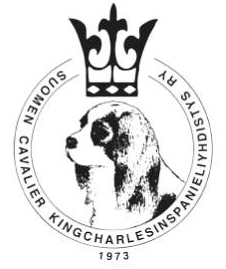 --- Finnish CKCS Club
--- Finnish CKCS Club
The national cavalier King Charles spaniel club in Finland (Suomen Cavalier Kingcharlesinspanieliyhdistys) and the Finnish Kennel Club (Suomen Kennelliitto -- FKC) combine forces to create a partially mandatory and partially not mandatory MVD breeding protocol. The FKC requires that cavaliers be examined by stethoscope (auscultated) before mating. If a murmur is detected, the dog may not be bred unless it first is determined by echocardiograph that it does not have mitral valve disease.
The Finnish CKCS club adds to that the recommendation that if the cavalier is under 3 years old, the dog must have no MVD murmur and either: (a) the dog's parents were MVD-clear at age 5 years, or (b) the dog is MVD-clear by echocardiograph. A revision of this breeding recommendation is being considered that would stiffen the protocol:
• If the cavalier is between 3 and 5 years old, the dog must have no MVD murmur and the dog's parents were MVD-clear at age 5 years.
• If the cavalier is between 2 and 3 years old, the dog must have no MVD murmur and the dog's parents were MVD-clear at age 6 years.
• If either of the male cavalier's parents had an MVD-murmur before age 5 years old, the dog cannot be bred before age 5 years old and MVD-clear.
On April 23, 2022, the membership of the Finnish Cavalier King Charles Spaniel Club unanimously approved the start of a cross-breeding program between purebred CKCSs and one or more other breeds which are free of the CKCS genetic disorders of early-onset mitral valve disease (MVD), syringomyelia, and Chiari-like malformation.
The stated goal of the cross-breeding program is to improve the breed's health, particularly regarding mitral valve disease (MVD), syringomyelia (SM) and possibly Chiari-like malformation (CM). The Finnish CKCS club has determined that purebred breeding cannot eradicate these conditions or even significantly decrease the number of affected dogs. The club’s plan is to carry out several litters with several breeds, in order to see long-term health results and to ensure sufficient material for further study. No decisions have yet been made as to which other breeds will be partnered with cavaliers. However, there will be guidelines, such as the partner breed must not show any brachycephalic traits, and its temperament must match that of the typical CKCS. All eventual cross-bred CKCS litters will be bred by registered cavalier breeders under the supervision of both the Finnish Kennel Club and the Finnish CKCS Club. A single cross-bred line will include four generations, the final one being FCI registered as purebred cavalier King Charles spaniel. Completing a single 4-generation line is estimated to take approximately 10 years.
On June 15, 2023, the Finnish Kennel Club accepted cross breeding projects for the CKCS breed, stating:
"The selected breeds for cross breeding the Cavalier are the Tibetan Terrier, the Danish-Swedish Farmdog, the Papillon/Phalene, the Beagle and possibly the Moyen poodle and the Japanese Spitz. These breeds are seen suitable based on their behaviour and character, and they are not known to have same or similar health issues than the Cavalier. The breed profile may still be changed during the project. It may be considered case-by-case how wide the health examinations should be for the mating partner."
RETURN TO TOP
--- French CKCS Club
 France's English Toy Spaniel Club (Club
des Epagneuls Nains Anglais), which includes both cavaliers and the
King Charles spaniel, instituted a voluntary MVD breeding protocol in
2001. It requires echocardiograph/color Doppler examinations for cavalier breeding
stock by cardiologists, beginning at age 18 months. The echocardiograph
scan either is conducted by a veterinary cardiologist or a specific still frame from the echo
scan, showing the end of the cardiac contraction, can be submitted to
the club for review and processing by the club's cardiologist, Dr.
Gérard Haroutunian.
France's English Toy Spaniel Club (Club
des Epagneuls Nains Anglais), which includes both cavaliers and the
King Charles spaniel, instituted a voluntary MVD breeding protocol in
2001. It requires echocardiograph/color Doppler examinations for cavalier breeding
stock by cardiologists, beginning at age 18 months. The echocardiograph
scan either is conducted by a veterinary cardiologist or a specific still frame from the echo
scan, showing the end of the cardiac contraction, can be submitted to
the club for review and processing by the club's cardiologist, Dr.
Gérard Haroutunian.
The club has established this five-stage grading system for categorizing the existence and degree of MVD in each dog:
• Stage/Grade 0: The mitral leaflets are intact; no thickening; no nodule; they close perfectly to the left ventricle throughout the cardiac contration phase.
• Stage/Grade 1: A discrete thickening or the presence of nodules, and a discrete flattening of the mitral valve leaflets (in reference to the plane of the mitral annulus). This flattening affects only the body of the leaflets and does not exceed the plane of the mitral annulus.
• Stage/Grade 2: Deformation and infiltration of both mitral valve leaflets are evident throughout the cardiac cycle. The leaflets appear elongated, are considerably flattened, and reach or exceed the plane of the mitral annulus.
• Stage/Grade 3: Deformation and mitral prolapse are even more obvious, but especially this stage is characterized by a highly visible expansion of the left atrium. These anomalies cause a failure to close and seal the valve, causing a leak itself to generate a mitral murmur. This murmur is constantly detectable in Stage 3, only slightly in Stage 2, depending on the quality of the stethoscope, the heart rate of the dog, the dog's weight status, breathing sounds, and a host ofexternal events making listening too random.
• Stage/Grade 4: Rupture of the chord(s) affects a large majority of mitral valve leaflets. Dilatation of the left atrium.
Following the initial examination at or after age 18 months, the breeding dogs must be re-examined every 18 months. The club allows dogs over age 3 years of age and in Stages 1 and 2 to be bred. Through September 2016, over 14,500 echo examinations have been submitted to the club, which includes repeat exams of many dogs.
--- Flemish (Belgium) Breeding Commission
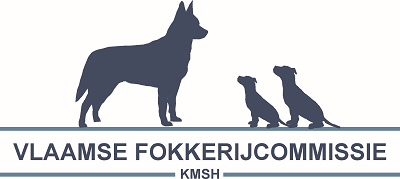 In
Belgium, the Flemish Breeding Commission has imposed a mandatory
restriction on the breeding of cavaliers. CKCSs under age 5 years are
excluded from breeding if they have an MVD murmur, unless "breeding
value estimates" are available. Dogs over age 5 years with a murmur are
not excluded provided that there is an official record that the dog was
murmur-free after the age of 3 years.
Details are here.
In
Belgium, the Flemish Breeding Commission has imposed a mandatory
restriction on the breeding of cavaliers. CKCSs under age 5 years are
excluded from breeding if they have an MVD murmur, unless "breeding
value estimates" are available. Dogs over age 5 years with a murmur are
not excluded provided that there is an official record that the dog was
murmur-free after the age of 3 years.
Details are here.
RETURN TO TOP
-- cavalier breeders' objections
 Since 1998, only an insignificant minority of breeders of cavalier King
Charles spaniels in the United States have followed the MVD breeding guidelines. In the
years since then, the vast majority of such breeders have squandered at
least six generations (at 2.5 years per generation) of cavaliers towards
eliminating early-onset (onset before age 5 years) mitral valve disease.
Since 1998, only an insignificant minority of breeders of cavalier King
Charles spaniels in the United States have followed the MVD breeding guidelines. In the
years since then, the vast majority of such breeders have squandered at
least six generations (at 2.5 years per generation) of cavaliers towards
eliminating early-onset (onset before age 5 years) mitral valve disease.
We now find some cavalier breeders who claim to be following an MVD breeding protocol which turns out not to be the MVD Breeding Protocol. Some breeders have made up their own watered-down breeding protocol (something like: "try to breed" females over 2 years of age and MVD-clear, to males over 6 years and MVD-clear), which makes breeding decisions much easier for them, but which totally ignores the many years of statistical research and cardiologists' and geneticists' recommendations which has led to the MVD Breeding Protocol.
 The American Cavalier King Charles Spaniel Club (ACKCSC), which is the
CKCS parent club of the American Kennel Club (AKC) has pointedly ignored the
MVD breeding protocol and has gone so far as to even concoct a fictitious
MVD breeding guideline of its own. On
its website (as of
Janauary 2017), the ACKCSC has stated:
The American Cavalier King Charles Spaniel Club (ACKCSC), which is the
CKCS parent club of the American Kennel Club (AKC) has pointedly ignored the
MVD breeding protocol and has gone so far as to even concoct a fictitious
MVD breeding guideline of its own. On
its website (as of
Janauary 2017), the ACKCSC has stated:
"Currently, the recommended practice is to wait until a Cavalier is two years old or older before the first breeding and to know the parents and ancestral cardiac status. Cavaliers with early onset presentations of MVD (before four years of age) should not be bred and breeders need to work with the guidance of their cardiologists."
Instead of not breeding until age 2.5 years, ACKCSC claims in its baseless "recommended practice" to start breeding at 24 months, and it also shortens the definition of early-onset MVD from five years to four years. Instead of requiring that all four parents of the breeding pair be certified to be murmur-free by age five years, ACKCSC says its "recommended practice" is simply "to know the parents and ancestral cardiac status." That is a meaningless phrase apparently designed to provide AKC breeders with "cover" for ignoring the real MVD breeding protocol. It allows them to claim that, in their "wisdom" as experienced breeders, they "know the parents" and they have taken into account the "ancestral cardiac status".
The ACKCSC, as the AKC's parent club for cavaliers, has been assigned by AKC the responsibility of "the education of breed owners on the nuances of the breed, and overseeing the breed's health and welfare." So, the ACKCSC is the primary source for AKC breeders to find out about the health of cavaliers. The ACKCSC has refused to accept that responsibility, and instead, it has misled the AKC breeders about the true MVD breeding protocol in the United States.
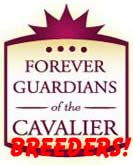 In April 2010, the
Cavalier King Charles Spaniel Club, USA (CKCSC,USA)
withdrew its 1998 endorsement of the MVD Breeding Protocol and replaced
it with a recommended guideline even more worthless than that of the ACKCSC.
The CKCSC,USA's new guideline is:
In April 2010, the
Cavalier King Charles Spaniel Club, USA (CKCSC,USA)
withdrew its 1998 endorsement of the MVD Breeding Protocol and replaced
it with a recommended guideline even more worthless than that of the ACKCSC.
The CKCSC,USA's new guideline is:
"The CKCSC,USA recommends that prior to breeding any Cavalier, the dog have 1) a clear rating at two years of age from an auscultation by a board certified veterinary cardiologist; ..."
This new worthless guideline ignores the research experts' conclusions that: (A) All four parents of the breeding pair be MVD-clear as of their 5th birthday; (B) The breeding pair be at least 30 months old and MVD-clear at the time of breeding; and (C) No cavalier be bred if diagnosed with an MVD murmur before its fifth birthday.
In October 2010, in the face of an onslaught of justifiable criticism, the board tweaked their bogus breeding recommendation thusly:
"The CKCSC,USA recommends that prior to breeding any Cavalier, the dog should have a heart clearance from an auscultation by a board certified veterinary cardiologist that is consistent with prevailing cardiology protocols; however, the CKCSC,USA recommends a minimum of a cardiology clearance at age 2.5 years by a board certified cardiologist."
So we find that the two CKCS breed clubs in the United States are not a part of the solution to early-onset mitral valve disease in the breed. Instead, these clubs are affirmatively contributing to the problem by enabling breeders to ignore the protocol and continue to breed generations of cavaliers destined to develop early-onset MVD. (As of January 2022, this remains the CKCSC,USA's breeding recommendation on its website.)
By shunning the real MVD Protocol and actually increasing the breedings of cavalier King Charles spaniels in violation of the MVD Protocol, the large majority of American breeders have acted in callous disregard for the health and welfare of future generations of cavaliers. They continue to breed untested, un-cleared, and/or under-aged cavalier King Charles spaniels in the United States, and the number of breedings and resulting litters of these early death-marked cavaliers has increased dramatically since the American breeders were warned by the experts in 1998 to stop breeding underaged cavaliers and never breed any cavalier in violation of the MVD Protocol.
Similarly, in the United Kingdom, the chairman of its Cavalier King Charles Spaniel Club stated in March 2009:
"There are many members who are still not prepared to health check their breeding stock, and of those who do, it would appear that many would not hesitate to breed from affected animals."
In 2010, 55% of all cavalier litters registered with the UK Kennel Club had at least one parent under the age of 2.5 years.
RETURN TO TOP
Research News
January 2025:
Danish Kennel Club opens its Stud Book to unregistered cavaliers
with MVD-clear hearts.
 The
Dansk (Danish) Kennel Club (DKK) announced that as of January 1,
2025 it has opened its Stud Book to admit unregistered cavalier King
Charles spaniels, "as a positive contribution to the development of the
breed and ensuring genetic variation in the breed." This means that
cavaliers in Denmark without FCI pedigreea that have an approved mitral
valve (MVD) examination can be registered in the DKK. The procedure to
determine eligibility is:
The
Dansk (Danish) Kennel Club (DKK) announced that as of January 1,
2025 it has opened its Stud Book to admit unregistered cavalier King
Charles spaniels, "as a positive contribution to the development of the
breed and ensuring genetic variation in the breed." This means that
cavaliers in Denmark without FCI pedigreea that have an approved mitral
valve (MVD) examination can be registered in the DKK. The procedure to
determine eligibility is:
• Have the dog's heart examined for MVD by a specially trained cardiologist.
• The dog must be at least 18 months old.
• The dog must be healthy and pass the DKK's MVD grading tests for mitral regurgitation murmurs and mitral valve prolapse by echocardiography.
If the dog passes that MVD test, then the dog is to be physically examined by a DKK judge to assess if the dog is "breed typical".
February 2024:
Study reports that Denmark's MVD breeding restrictions have
reduced early-onset MVD prevalence, excluding only 5% from breeding.
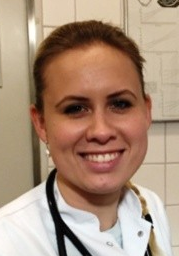 In
a
February 2024 article, Danish researchers (Maiken B. T. Bach
[right], Camilla L. Stougaard, Maria S. Thøfner, Maria J. Reimann,
Ulrik Westrup, Jørgen Koch, Merete Fredholm, Torben Martinussen, Mette
Berendt, Lisbeth H. Olsen) compared the mitral valve measurements of the
left atrium and left ventricle and murmur grade of 55 cavalier King
Charles spaniels which also had been MRI scanned and diagnosed with or
without syringmyelia (SM). Of the 55 CKCSs, 22 had symptomatic SM, 18
had asymptomatic SM, and 15 had no SM. Of the 55 cavaliers, 13 had no
MVD signs, 32 were diagnosed with MVD Stage B1, 7 with Stage B2, and 3
with Stage C. In Denmark, MVD breeding restrictions issued by
the Danish Kennel Club, assessing mitral regurgitation murmurs and
mitral valve prolapse severities have proven to effectively reduce the
prevalence of early-onset MVD in CKCS, excluding only approximately 5%
from breeding. Therefore, one of the investigators' motivations
was a concern that those Danish breeding restrictions could potentially
influence the prevalence of SM. The secondary aim of the study was to
investigate the severity of MVD in SM-affected cavaliers with and
without clinical signs of SM. The investigators report finding no
significant difference in left atrial (LA) and left ventricle (LV)
measurements between CKCSs with or without SM. However, they did find
that CKCS with symptomatic SM had "significantly smaller" LA and LV
dimensions, compared to those with asymptomatic SM and those without SM.
In
a
February 2024 article, Danish researchers (Maiken B. T. Bach
[right], Camilla L. Stougaard, Maria S. Thøfner, Maria J. Reimann,
Ulrik Westrup, Jørgen Koch, Merete Fredholm, Torben Martinussen, Mette
Berendt, Lisbeth H. Olsen) compared the mitral valve measurements of the
left atrium and left ventricle and murmur grade of 55 cavalier King
Charles spaniels which also had been MRI scanned and diagnosed with or
without syringmyelia (SM). Of the 55 CKCSs, 22 had symptomatic SM, 18
had asymptomatic SM, and 15 had no SM. Of the 55 cavaliers, 13 had no
MVD signs, 32 were diagnosed with MVD Stage B1, 7 with Stage B2, and 3
with Stage C. In Denmark, MVD breeding restrictions issued by
the Danish Kennel Club, assessing mitral regurgitation murmurs and
mitral valve prolapse severities have proven to effectively reduce the
prevalence of early-onset MVD in CKCS, excluding only approximately 5%
from breeding. Therefore, one of the investigators' motivations
was a concern that those Danish breeding restrictions could potentially
influence the prevalence of SM. The secondary aim of the study was to
investigate the severity of MVD in SM-affected cavaliers with and
without clinical signs of SM. The investigators report finding no
significant difference in left atrial (LA) and left ventricle (LV)
measurements between CKCSs with or without SM. However, they did find
that CKCS with symptomatic SM had "significantly smaller" LA and LV
dimensions, compared to those with asymptomatic SM and those without SM.
May 2018:
UK Kennel Club announces new MVD breeding scheme for cavaliers.
 In a
May 2018 press release, the The UK Kennel Club and the UK
Veterinary Cardiovascular Society announced on May 21, 2018 that they
have developed a new MVD breeding scheme for cavalier King Charles
spaniels. Application of the breed scheme will begin with a trial of 100
dogs, and later this year, it will be available to all cavalier breeders
and owners.
See this UK Kennel Club webpage for the details.
In a
May 2018 press release, the The UK Kennel Club and the UK
Veterinary Cardiovascular Society announced on May 21, 2018 that they
have developed a new MVD breeding scheme for cavalier King Charles
spaniels. Application of the breed scheme will begin with a trial of 100
dogs, and later this year, it will be available to all cavalier breeders
and owners.
See this UK Kennel Club webpage for the details.
The new testing scheme is:
1. FIRST EXAMINATION: Beginning between age 18 months to 2 years, breeding stock cavaliers should be examined by a cardiologist by stethoscope (auscultation) to determine if they have a mitral valve murmur, and by echocardiograph (Doppler), to determine if they have mitral valve prolapse and to confirm whether the murmur is in fact from the mitral valve.
2. SUBSEQUENT EXAMINATIONS: If the dogs are still being used for breeding, re-assessments should be performed at ages 4 years and 6 years.
3. MURMURS: Mitral valve murmurs will be graded from 0 to 6, with 0 indicating no murmur and 6 indicating the most severe murmur.
4. PROLAPSE: Mitral valve prolapse (MVP) will be graded 0 to 3, as follows:
• 0 – none
• 1 – mild
• 2 – moderate
• 3 – severe
5. A GREEN – AMBER – RED color system has been devised as shown on
this chart:
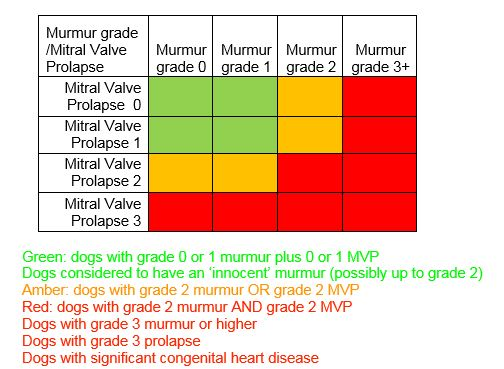
• GREEN: Cavaliers with Grade 0 or 1 murmur and Grade 0 or 1 MVP are be considered to be at the lowest risk of developing congestive heart failure (CHF) from MVD, and therefore represent the lowest breeding risk.
• AMBER: Cavaliers with a Grade 2 murmur OR Grade 2 MVP (but not both) have a greater risk of developing CHF or passing the condition on to offspring.
The UK Kennel Club advises that, to reduce the genetic risk of MVD in offspring, only Amber dogs otherwise in excellent health, and with good results from other screening schemes, may be used cautiously for breeding, with particular care to use mates which have been categorized as Green under the scheme, preferably at 4 years of age or older.
Dogs categorized as Amber at ages 4 or 6 years (or older) are considered to represent less of a risk than those categorized as Amber at the first examination at 18 months to 2 years.
• RED: Cavaliers with both a Grade 2 murmur AND a Grade 2 MVP, or a Grade 3 murmur or above, or a Grade 3 MVP, or otherwise have significant heart disease, are advised not to be used for breeding, as they are considered to represent the greatest breeding risk.
6. RECORD OF EXAMINATION: The detailed results of the examinations, including the Doppler images, will be recorded on an electronic form, which will be distributed to the dog’s owner, the Kennel Club, and the examining cardiologist. In the Comment section of the form, the cardiologist may state that the dog is “heart recommended or not recommended for breeding”. The Kennel Club will add the grades to the dog’s record. At the time of the assessment, the cardiologist will stamp the dog’s registration certificate if the dog’s owner requests.
7. APPEALS: Owners may have the result reviewed on appeal to the Breed Health VCS Committee for a fee. An independent VCS trained cardiologist, (blinded to the VCS cardiologist and original result) will review the Doppler images. If the reviewing cardiologist agrees with the first screener there is no further action and the certification stands.
April 2017:
UK Kennel Club spokesman trashes the MVD Breeding Protocol.
 In
a statement included in a
DogWorld.co.uk article published in April, 2017, UK Kennel Club
secretary Caroline Kisko (right) announced that the Kennel Club
rejects the MVD Breeding Protocol because it requires "breeding from
older bitches." The protocol, which was introduced in the UK in 1996 and
has been endorsed by the UK Cavalier Club, calls for not breeding any
cavalier until they reach the age of 2.5 years. The protocol has been
proven effective in reducing the early onset of mitral valve disease in
offspring. Ms. Kisko in effect ridiculed the protocol by declaring that
2.5 year old CKCS dams are "older bitches".
In
a statement included in a
DogWorld.co.uk article published in April, 2017, UK Kennel Club
secretary Caroline Kisko (right) announced that the Kennel Club
rejects the MVD Breeding Protocol because it requires "breeding from
older bitches." The protocol, which was introduced in the UK in 1996 and
has been endorsed by the UK Cavalier Club, calls for not breeding any
cavalier until they reach the age of 2.5 years. The protocol has been
proven effective in reducing the early onset of mitral valve disease in
offspring. Ms. Kisko in effect ridiculed the protocol by declaring that
2.5 year old CKCS dams are "older bitches".
April 2017:
Analysis of UK breeders' compliance with the MVD Breeding
Protocol shows breeders' hypocrisy.
 In an
April 2017 article by Cavaliers Are Special, the breeding and health
testing records of 114 top points-winning UK cavalier King Charles
spaniels are analyzed to determine their breeders' compliance with the
UK cavalier club's MVD Breeding Protocol. The results:
In an
April 2017 article by Cavaliers Are Special, the breeding and health
testing records of 114 top points-winning UK cavalier King Charles
spaniels are analyzed to determine their breeders' compliance with the
UK cavalier club's MVD Breeding Protocol. The results:
"From 2012 to 2016 inclusive these prize-winning Cavaliers produced 755 litters. Of these, 345 (46%) were bred by the Club Committee/Puppy Coordinator group. There were 229 litters with one or both parents under 2.5 years (30%). Of the 345 litters, 135 bred by the Club Committee/Puppy Coordinator group (39%) had one or both parents under 2.5. Non-compliance with age guidelines with breeders outside this group was 23% (94 of 410 litters)."
The study concludes:
"Non-compliance with MVD breeding guidelines is noteworthy among the owners of these top, prize-winning Cavaliers and is significantly and consistently higher among the 'Club Committee/Puppy Coordinator' group. Given the influence these high-profile breeders have on the wider world of Cavalier breeding, this should raise concern. Such widespread non-compliance also reveals a huge gulf between what these breeders say about their commitment to Cavalier health, and what happens in practice. With no heart health gains over the past 20 years for Club cavaliers, it is difficult to see there ever being an improvement in rates of MVD and a lowering of the age of its onset in Cavaliers without mandatory heart testing. At the very least, those with positions of responsibility within the breed clubs (especially those reporting to the Kennel Club on matters of health) should follow breeding guidelines. The Kennel Club has repeatedly said that it does not think mandatory testing for breeding Cavaliers is the answer, a stance taken yet again at Crufts in March. Yet on the same day the KC made its statement on this issue, a judge awarded Best of Breed to a cavalier that had only turned 2.5 the week prior to Crufts but had already sired 7 litters in the UK, the first when only 13 months old. Campaigners, including many high-profile veterinarians, have insisted that given the severity and extent of inherited health issues faced by Cavaliers, the breed should be treated as a special case, and that special measures (such as mandatory testing and breeding protocols for the two most severe and widespread conditions, MVD and Syringomyelia) be adopted. The evidence from this analysis strengthens this argument as it clearly shows that as long as guidelines and testing remain optional, even the most senior and influential Club breeders routinely ignore health breeding guidelines themselves."
January 2017:
UK study of 8,860 cavaliers shows that MVD Breeding Protocol
works but breeders' compliance was poor.
 In a
January 2017 article, researchers (Simon Swift [right], A. Baldin, P. Cripps)
reviewed the records of 8,860 UK cavalier King Charles spaniels from
1991 through 2010. The records were reported by veterinarians on dogs
presented voluntarily by breeders at CKCS club conformation shows or to
their local veterinary practices and relied upon completed forms being
returned to the central database. Therefore, the researchers report,
some younger dogs with murmurs detected by their local veterinarians may
not have been presented at shows, or their forms not returned if a
murmur was detected. The results:
In a
January 2017 article, researchers (Simon Swift [right], A. Baldin, P. Cripps)
reviewed the records of 8,860 UK cavalier King Charles spaniels from
1991 through 2010. The records were reported by veterinarians on dogs
presented voluntarily by breeders at CKCS club conformation shows or to
their local veterinary practices and relied upon completed forms being
returned to the central database. Therefore, the researchers report,
some younger dogs with murmurs detected by their local veterinarians may
not have been presented at shows, or their forms not returned if a
murmur was detected. The results:
• 16,887 examinations were performed on 8,860 cavaliers to detect mitral valve disease (MVD) murmurs.
• Males developed murmurs earlier than females -- median age difference was 0.5 years.
• Cardiologists detected murmurs in younger dogs compared to general practice (GP) veterinarians with a difference in the median age of 1.4 years.
• The age incidence of MVD murmurs might be increased if breeders followed the MVD breeding guidelines.
• Compliance of UK breeders with this voluntary scheme has been poor.
• Wider participation or a mandatory protocol is likely to result in a greater effect on the age incidence.
November 2016:
UK Kennel Club approves MVD testing scheme for cavaliers.
 In
a
November 2016 press release, the UK Kennel Club announced that it
has approved a health testing scheme for cavalier King Charles spaniels,
with the intended result of "dramatically" improving the heart health of
the CKCS. Apparently, the move was motivated by the
January 2016 article reporting on Denmark's mandatory testing
policy. The UK program will consist of veterinary
cardiologists examining cavaliers to determine if each dog has a mitral
valve murmur. An echocardiograph scan also will be performed and sent to
Dr. Lisbeth Høier Olsen in Denmark, for her to measure the heart. Each
dog will be issued a certificate from the University of Copenhagen, with
both a murmur and mitral valve prolapse score. The Kennel Club will
record the certificate results on the dog's registration record and made
available publicly. The Kennel Club also intends to update MVD breeding
recommendations for cavaliers.
In
a
November 2016 press release, the UK Kennel Club announced that it
has approved a health testing scheme for cavalier King Charles spaniels,
with the intended result of "dramatically" improving the heart health of
the CKCS. Apparently, the move was motivated by the
January 2016 article reporting on Denmark's mandatory testing
policy. The UK program will consist of veterinary
cardiologists examining cavaliers to determine if each dog has a mitral
valve murmur. An echocardiograph scan also will be performed and sent to
Dr. Lisbeth Høier Olsen in Denmark, for her to measure the heart. Each
dog will be issued a certificate from the University of Copenhagen, with
both a murmur and mitral valve prolapse score. The Kennel Club will
record the certificate results on the dog's registration record and made
available publicly. The Kennel Club also intends to update MVD breeding
recommendations for cavaliers.
November 2016: Simon Swift calls for parents/grandparents of UK show cavaliers to meet MVD breeding protocol -- only 4% of CKCSs have been meeting that protocol. In a letter to the Veterinary Times published in October 2016, cardiologist Simon Swift called for the UK Kennel Club to require that the parents of all show CKCSs be tested and cleared for MVD at age five years. If the parents are not yet five years old, then he writes that the show dogs' grandparents meet that test standard.
He also noted:
"Examining dogs on the database for the period between 2006 and 2010 showed only four per cent ofdogs had followed this breeding advice -- that is, had parents or grandparents tested clear older than five years."
EDITOR'S NOTE: Dr. Swift's observation that only 4% of cavaliers being bred in the UK in accordance with the MVD Breeding Protocol is a sad acknowledgement that nearly all CKCS breeders are more concerned about their kennels' success than about the health and welfare of the dogs they produce.
November 2015:
Denmark Kennel Club proves a rigorous mandatory MVD breeding protocol
works.
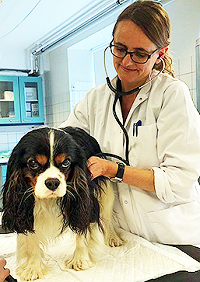 In a
January 2016 article, a team of Danish and
Swedish cardiologists (A.C. Birkegård, M.J. Reimann, T. Martinussen, J.
Häggström, H.D. Pedersen, L.H. Olsen [right]) report that the Danish Kennel
Club's 2001 mandatory MVD breeding scheme has reduced the risk of having
a mitral regurgitation murmur caused by MMVD by 73% among 997 cavalier
King Charles spaniels.
In a
January 2016 article, a team of Danish and
Swedish cardiologists (A.C. Birkegård, M.J. Reimann, T. Martinussen, J.
Häggström, H.D. Pedersen, L.H. Olsen [right]) report that the Danish Kennel
Club's 2001 mandatory MVD breeding scheme has reduced the risk of having
a mitral regurgitation murmur caused by MMVD by 73% among 997 cavalier
King Charles spaniels.
Denmark's MVD breeding guidelines are:
1. Dogs examined at 1½ years of age or older were approved for breeding until 4 years of age if cardiac health criteria were fulfilled.
2. To continue breeding after 4 years of age, the dogs had to be reexamined. In January 2007, an additional restriction was added, requiring a reexamination after 6 years of age for male dogs.
3. At all examination time points, dogs were excluded from breeding if they had MVP (mitral valve prolapse by echocardiograph) grade 3 or a mitral regurgitation murmur grade 3 or higher.
4. The degree of MVP was assessed as:
• Grade 0 (≤1.5 mm as the sum of the maximum protrusion of the cranial, caudal and coaption point of the mitral valve according to annulus plane)
• Grade 1 (>1.5 and ≤4.5 mm)
• Grade 2 (>4.5 and ≤7.5 mm)
• Grade 3 (>7.5 mm).
5. • Dogs with grade 2 murmurs were excluded if they had MVP grades 2 or 3;
• Mitral regurgitation murmur of 1 at a maximum combined with a MVP grade 2 at a maximum; or
• A grade 2 murmur combined with a degree of MVP not above grade 1.
• Before 2007, dogs with a grade 3 MVP were approved if they had a murmur grade not above 1.
The researchers concluded:
"Our study shows that a breeding scheme based on cardiac auscultation and echocardiography markedly decreased the risk of having a mitral regurgitation murmur caused by MMVD after an 8- to 10-year period. The reduction in risk was only significant for offspring where both parents had been approved by the breeding scheme (PB), not for offspring where 1 or both parents not were approved by the breeding scheme (non-PB). The risk of having moderate to severe MVP (MVP > 1) was not decreased after the 8- to 10-year period, but PB had lower risk of MVP > 1 than did non-PB within the years 2010 and 2011. ... A mandatory breeding scheme based on auscultation and echocardiography findings significantly decreased the prevalence of MMVD over the 8- to 10-year period. Such a breeding scheme therefore is recommended for CKCS."
June 2015:
Danish kennel club
continues its cavalier MVD breeding protocol
through May 2017.
 The Danish (Dansk) Kennel Club (DKK) has ordered that,
beginning in June 2015, the mandatory cavalier breeding protocol
continue through May 2017. The DKK stated that, if in the course
of this two-year period any new studies demonstrate the same or better
effect of simpler or cheaper breeding programs, the DKK and the Danish
cavalier club can enter into dialogue about whether the current breeding
protocol be changed.
The Danish (Dansk) Kennel Club (DKK) has ordered that,
beginning in June 2015, the mandatory cavalier breeding protocol
continue through May 2017. The DKK stated that, if in the course
of this two-year period any new studies demonstrate the same or better
effect of simpler or cheaper breeding programs, the DKK and the Danish
cavalier club can enter into dialogue about whether the current breeding
protocol be changed.
The DKK based its decision upon a report presented to the Euoropean Society of Veterinary Cardiology at a meeting in September 2014, by Drs. Lisbeth Høier Olsen (right) and Jens Häggström and Simon Swift, comparing the results thus far of the Danish, Swedish, and UK breeding protocols. Their conclusions will be published in a scientific paper in 2015. Dr. Olsen previously had stated:
"The Danish breeding program (mandatory, auscultation and heart scan at 1½, 4 and dogs 6 years) seems more effective than the English and Swedish (only auscultation, but every year, and the inclusion of parents animal cardiac status). The Swedish program is mandatory while the UK voluntarily ."
June 2013: Danish
cavaliers show 71% reduced risk of MVD under a mandatory breeding
protocol.
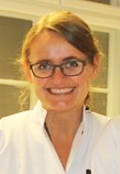 In a
June 2013 report to the clubs and to the ACVIM, Dr. Lisbeth Høier
Olsen (right) stated that in 2011, 997 Danish CKCSs were examined under the
Danish Kennel Club's mandatory breeding program during the period from
2002 to 2011. Each dog was evaluated from one to four times for a total
of 1,380 examinations by auscultation and echocardiography. The study
found that the risk of having MVD in 2010-2011 was compared to the
period 2002-2003 for cavaliers which were the offspring of parents in
the mandatory breeding protocol and those which were not (such as
imported cavaliers). In 2010-2011, the examined dogs within the club's
breeding protocol had a 71% reduced risk of having MVD than dogs in
2002-2003. As for offspring of parents not subject to the breeding
protocol, the reduced risk of having MVDM did not reach statistical
significance.
In a
June 2013 report to the clubs and to the ACVIM, Dr. Lisbeth Høier
Olsen (right) stated that in 2011, 997 Danish CKCSs were examined under the
Danish Kennel Club's mandatory breeding program during the period from
2002 to 2011. Each dog was evaluated from one to four times for a total
of 1,380 examinations by auscultation and echocardiography. The study
found that the risk of having MVD in 2010-2011 was compared to the
period 2002-2003 for cavaliers which were the offspring of parents in
the mandatory breeding protocol and those which were not (such as
imported cavaliers). In 2010-2011, the examined dogs within the club's
breeding protocol had a 71% reduced risk of having MVD than dogs in
2002-2003. As for offspring of parents not subject to the breeding
protocol, the reduced risk of having MVDM did not reach statistical
significance.
 May
2013: Sweden's
cavaliers show great progress against MVD in 2012. The
Swedish Kennel Club reports that of 988 cavaliers tested in 2012 for
mitral valve disease, only six under the age of four years had murmurs, and
only 61 of all of them had murmurs. The Swedish Kennel Club and the Swedish
Cavalier Club follow a mandatory modified version of the MVD breeding
protocol. See its breeding protocol here.
May
2013: Sweden's
cavaliers show great progress against MVD in 2012. The
Swedish Kennel Club reports that of 988 cavaliers tested in 2012 for
mitral valve disease, only six under the age of four years had murmurs, and
only 61 of all of them had murmurs. The Swedish Kennel Club and the Swedish
Cavalier Club follow a mandatory modified version of the MVD breeding
protocol. See its breeding protocol here.
The Swedish clubs do not require that all stethoscopic examinations of the cavaliers' hearts be performed by veterinary cardiologists, which is a requirement of the MVD Breeding Protocol. However, all Swedish veterinarians who are licensed to issue clear-heart certfiicates for this registry must pass an auscultation examination conducted by Sweden's top cardiologists/researchers, Professors Clarence Kvart and Jens Häggström.
2011:
Dutch CKCS club implements mandatory MVD breeding tests.
 The Dutch
cavalier King Charles spaniel club (Cavalier Club Nederland) and the Dutch
Kennel club has implemented a mandatory modified version of the MVD breeding
protocol. In theirs, all breeding stock cavaliers must have their hearts
examined by ultrasound at age one year or prior to breeding. Thereafter,
their hearts must be re-examined by auscultation by a specialist. If a
mitral valve murmur is detected before the dog's fifth birthday, it may not
be bred.
The Dutch
cavalier King Charles spaniel club (Cavalier Club Nederland) and the Dutch
Kennel club has implemented a mandatory modified version of the MVD breeding
protocol. In theirs, all breeding stock cavaliers must have their hearts
examined by ultrasound at age one year or prior to breeding. Thereafter,
their hearts must be re-examined by auscultation by a specialist. If a
mitral valve murmur is detected before the dog's fifth birthday, it may not
be bred.
2011:
Canada's CKCS club endorses MVD Breeding Protocol. The Canadian
cavalier club has
 endorsed
the MVD breeding protocol. On
its
website, it states:
endorsed
the MVD breeding protocol. On
its
website, it states:
"The Cavalier King Charles Spaniel Club Of Canada has recently included the recommendation within its Breeders' Guidelines that Breeders breed Cavalier King Charles Spaniels that are at least 2.5 years old and murmur-free that have parents that were murmur-free at age 5 years."
However, the Canadian club's version of the MVD Breeding Protocol does not require that veterinary cardiologists perform the stethoscopic examinations for heart murmurs.
January 2011: UK CKCS breeders still largely ignore the MVD Breeding Protocol. In 2010, 55% of all cavalier litters registered with the UK Kennel Club had at least one parent under the age of 2.5 years.
October 2010:
CKCSC,USA modifies its new phony MVD breeding protocol.
 In
April 2010, the
CKCSC,USA's board of directors replaced the REAL protocol with a worthless
watered-down version, in which they stated:
In
April 2010, the
CKCSC,USA's board of directors replaced the REAL protocol with a worthless
watered-down version, in which they stated:
"The CKCSC,USA recommends that prior to breeding any Cavalier, the dog have a clear rating at two years of age from an auscultation by a board certified veterinary cardiologist."
In the face of an onslaught of justifiable criticism, the board met in October and tweaked their bogus breeding recommendation thusly:
"The CKCSC,USA recommends that prior to breeding any Cavalier, the dog should have a heart clearance from an auscultation by a board certified veterinary cardiologist that is consistent with prevailing cardiology protocols; however, the CKCSC,USA recommends a minimum of a cardiology clearance at age 2.5 years by a board certified cardiologist."
This October revision is only a miniscule improvement over their April version and is still worthless. It ignores these essential elements of the REAL protocol:
• Do not breed any cavalier under the age of 5 years, unless its parents' hearts were free of MVD murmurs by age 5 years.
• Do not breed any cavalier who is diagnosed with an MVD murmur under the age of 5 years.
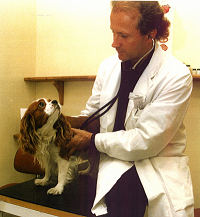 September 2010:
Swedish Kennel Club's modified mandatory MVD breeding protocol is not
showing progress. In a
2010 study
by cardiologist Dr. Clarence Kvart (right) of the
mandatory Swedish CKCS club breeding protocol -- which is weaker than the
MVD protocol recommended by Lennart Swenson -- Dr. Kvart reports that that
the prevalence of MVD in six-year-old cavalier King Charles spaniels, born
2001 and 2003, is at least 50% and lacks signs of decrease despite the
current breeding program introduced in Sweden 2001. The Swedish clubs
have declined to toughen their program to match Prof.
Swenson's recommendation.
September 2010:
Swedish Kennel Club's modified mandatory MVD breeding protocol is not
showing progress. In a
2010 study
by cardiologist Dr. Clarence Kvart (right) of the
mandatory Swedish CKCS club breeding protocol -- which is weaker than the
MVD protocol recommended by Lennart Swenson -- Dr. Kvart reports that that
the prevalence of MVD in six-year-old cavalier King Charles spaniels, born
2001 and 2003, is at least 50% and lacks signs of decrease despite the
current breeding program introduced in Sweden 2001. The Swedish clubs
have declined to toughen their program to match Prof.
Swenson's recommendation.
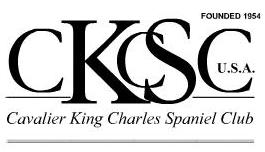 April 2010: CKCSC,USA dumps MVD Breeding
Protocol. The Cavalier King Charles Spaniel Club, USA (CKCSC,USA)
has withdrawn its 1998 endorsement of the MVD Breeding Protocol and replaced
it with a recommended guideline even more worthless than that of the ACKCSC.
The CKCSC,USA's new guideline is:
April 2010: CKCSC,USA dumps MVD Breeding
Protocol. The Cavalier King Charles Spaniel Club, USA (CKCSC,USA)
has withdrawn its 1998 endorsement of the MVD Breeding Protocol and replaced
it with a recommended guideline even more worthless than that of the ACKCSC.
The CKCSC,USA's new guideline is:
"The CKCSC,USA recommends that prior to breeding any Cavalier, the dog have 1) a clear rating at two years of age from an auscultation by a board certified veterinary cardiologist; ..."
This new worthless guideline ignores the research experts' conclusions that: (A) All four parents of the breeding pair be MVD-clear as of their 5th birthday; (B) The breeding pair be at least 30 months old and MVD-clear at the time of breeding; and (C) No cavalier be bred if diagnosed with an MVD murmur before its fifth birthday.
2010:
ACKCSC concocts fictitious, worthless MVD breeding guideline. The American Cavalier
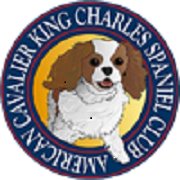 King Charles Spaniel Club (ACKCSC), which is the
CKCS parent club of the American Kennel Club (AKC) has pointedly ignored the
MVD breeding protocol and has gone so far as to even concoct a fictitious
MVD breeding guideline of its own. On its website, the ACKCSC has stated:
King Charles Spaniel Club (ACKCSC), which is the
CKCS parent club of the American Kennel Club (AKC) has pointedly ignored the
MVD breeding protocol and has gone so far as to even concoct a fictitious
MVD breeding guideline of its own. On its website, the ACKCSC has stated:
"Currently, the recommended practice is to wait until a Cavalier is two years old or older before the first breeding and to know the parents and ancestral cardiac status. Cavaliers with early onset presentations of MVD (before four years of age) should not be bred and breeders need to work with the guidance of their cardiologists."
Instead of not breeding until age 2.5 years, ACKCSC claims in its baseless "recommended practice" to start breeding at 24 months, and it also shortens the definition of early-onset MVD from five years to four years. Instead of requiring that all four parents of the breeding pair be certified to be murmur-free by age five years, ACKCSC says its "recommended practice" is simply "to know the parents and ancestral cardiac status." That is a meaningless phrase apparently designed to provide AKC breeders with "cover" for ignoring the real MVD breeding protocol. It allows them to claim that, in their "wisdom" as experienced breeders, they "know the parents" and they have taken into account the "ancestral cardiac status".
The ACKCSC, as the AKC's parent club for cavaliers, has been assigned by AKC the responsibility of "the education of breed owners on the nuances of the breed, and overseeing the breed's health and welfare." So, the ACKCSC is the primary source for AKC breeders to find out about the health of cavaliers. The ACKCSC has refused to accept that responsibility, and instead, it has misled the AKC breeders about the true MVD breeding protocol in the United States.
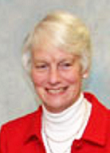 March 2009:
UK's cavalier club chairman says many club breeders ignore health checks.
Mrs. Lesley Jupp (right), Chairman of the Cavalier King Charles Spaniel Club of the
UK, stated on March 24, 2009:
March 2009:
UK's cavalier club chairman says many club breeders ignore health checks.
Mrs. Lesley Jupp (right), Chairman of the Cavalier King Charles Spaniel Club of the
UK, stated on March 24, 2009:
"There are many members who are still not prepared to health check their breeding stock, and of those who do, it would appear that many would not hesitate to breed from affected animals."
RETURN TO TOP
Related Links
RETURN TO TOP
Veterinary Resources
Mitral Valve Disease in Cavalier King Charles Spaniels. Darke, P., Fuentes VL, Kvart C, Häggström J. Swenson L. Proceedings, Seminar by Intervet UK Ltd and The Cavalier King Charles Spaniel Club UK. November 1996.
International Symposium on Chronic Cardiac Valve Disease in the Cavalier King Charles Spaniel. Beardow A, Buchanan J, Fuentes VL, Keene B, Swenson L. Transcript of Private Recording of Proceedings, CKCSC,USA. May 1998.
Evaluation of the Swedish breeding program for cavalier King Charles spaniels. Tobias Lundin, Clarence Kvart. Acta Veterinaria Scandinavica, Sept. 2010, 52:54. Quote: "The Swedish Kennel club and the Special club for cavalier King Charles spaniels (SCKCS) started a breeding program in 2001 with the aim of reducing MMVD in the Swedish population of CKCS. In this program, dogs are not allowed to breed until four years of age and need a heart auscultation without murmurs within eight months before mating. However, dogs are allowed to breed at an age of 24 months, if the dog and its parents are examined and no murmurs are detected. Male dogs that have a heart auscultation at seven years of age without murmurs are allowed to breed without further heart evaluation. Breeding animals whose parents have heart murmurs before four years of age are not allowed to breed. The aim of this investigation was to study the prevalence of heart murmurs in the Swedish population of six-year-old CKCS born 2001 and 2003, and to estimate if prevalence has decreased since the breeding program was introduced 2001. ... In this investigation 353 CKCS were selected as a sample of the population and 150 were examined by auscultation for heart murmurs when they reached the age of six years in 2007 and 2009. ... The effect of the breeding program was evaluated by comparing the prevalence of heart murmurs in the two groups. In 2007, the prevalence of heart murmurs was 52% (50% for females and 54% for males) and in 2009, the prevalence was 55% (44% for females and 67% for males). No significant difference was found in the prevalence of heart murmurs between 2007 and 2009 (P=0.8). For all six-year-old CKCS, the prevalence of heart murmur was 53% (females 46% and males 61%), which is higher than previous Swedish investigations. ... The result from this investigation indicates that the prevalence of MMVD in six-year-old cavalier King Charles spaniels, born 2001 and 2003, is at least 50% and lacks signs of decrease despite the current breeding program introduced in Sweden 2001."
Heritability of premature mitral valve disease in Cavalier King Charles spaniels. Tom Lewis, Simon Swift, John A. Woolliams, and Sarah Blott. Vet J, April 2011, 188(1):73-76. Quote: "Mixed model analysis of 1252 records of cardiac auscultation of ≥4- to <5-year-old Cavalier King Charles spaniels (CKCS) from 1991 to 2008 in conjunction with the Kennel Club pedigree records of all dogs registered from the mid 1980s to September 2007 was used to estimate variance parameters of premature mitral valve disease (MVD). Data were limited to dogs 4 and <5 years of age to ensure diagnostic distinction between early and late onset MVD. Cardiac murmurs were detected in 108/1252 (8.6%) dogs. Heritability estimates of 0.67 (standard error, SE 0.071) for the grade of murmur and 0.33 (SE 0.072) for the presence/absence of murmur were calculated. The variance due to clinician was 0.02 (SE 0.012) for grade and 0.03 (SE 0.017) for presence/absence of murmur. These results indicate that the presence and severity of MVD, as assessed by cardiac auscultation, in 4- to 5-year-old CKCS is highly heritable and that selection against the disease should be successful."
Evaluation of the breeding program aiming at reducing the prevalence of myxomatous mitral valve disease in cavalier King Charles spaniels in Denmark. Birkegaard AC, Reimann MJ, Häggström J, Martinussen T, Pedersen HD, Olsen LH. ACVIM Conference. June 2013. Quote: "Cavalier King Charles spaniels (CKCS) are predisposed to myxomatous mitral valve disease (MMVD). Studies have demonstrated a strong genetic background. The objective of the study was to evaluate the effect of a breeding program involving auscultation and echocardiography aimed at reducing the prevalence of MMVD. Purebred CKCS (n=997) were examined for the Danish Kennel Club mandatory breeding program during the period from 2002 to 2011. Each dog was evaluated 1-4 times with the total of 1380 examinations. Auscultation and echocardiography were performed to evaluate mitral regurgitation murmur (MRM) severity and degree of mitral valve prolapse (MVP). The risk of having MRM in 2010-2011 compared to 2002-2003 was estimated using linear regression test (exact condition binary logistic regression), adjusting for repeated measurements. In 2010-2011, dogs were estimated to have 71% reduced risk of having MRM than dogs in 2002-2003 if they were a product of the breeding program (P=0.0017). A dog was defined as a product of the breeding program if both parents where approved by the breeding program. If non-products of the breeding program (for example imported dogs with parents with unknown cardiac status) were included in the analysis, reduced risk of having MRM did not reach statistical significance (OR 1.71; P=0.06). In conclusion, the mandatory breeding program, based on auscultation and echocardiography, significantly reduced the prevalence of MMVD over the 8 to 10-year period. Therefore, such breeding programs are recommended for CKCS."
Breeding Restrictions Decrease the Prevalence of Myxomatous Mitral Valve Disease in Cavalier King Charles Spaniels over an 8- to 10-Year Period. A.C. Birkegård, M.J. Reimann, T. Martinussen, J. Häggström, H.D. Pedersen (HDP), L.H. Olsen (LHO). J. Vet. Int. Med. January 2016;30(1):63–68. Quote: "Background: Cavalier King Charles Spaniels (CKCS) are predisposed to myxomatous mitral valve disease (MMVD). Studies have indicated a strong genetic background. Objective: The aim of this study was to evaluate the effect of a breeding scheme involving auscultation and echocardiography. Animals: In the Danish Kennel Club mandatory breeding scheme, 997 purebred CKCS were examined during the period 2002–2011. Each dog was evaluated 1–4 times with a total of 1,380 examinations. Methods: Auscultation and echocardiography were performed to evaluate mitral regurgitation murmur severity and degree of mitral valve prolapse (MVP). ... Echocardiographic Assessment of MVP: The degree of MVP was evaluated by LHO or HDP (MVP observers). The degree of MVP was assessed as 0 (≤1.5 mm as the sum of the maximum protrusion of the cranial, caudal and coaption point of the mitral valve according to annulus plane), 1 (>1.5 and ≤4.5 mm), 2 (>4.5 and ≤7.5 mm), and 3 (>7.5 mm). One of the MVP observers (HDP) evaluated the MVP echocardiograms from the debut of the breeding scheme until November 2004, hereafter the recordings were evaluated by the other MVP observer (LHO). ... Breeding Guidelines and Cardiac Health Criteria: Dogs examined ≥1½ years of age were approved for breeding until 4 years of age if cardiac health criteria were fulfilled. To continue breeding in DKCS after 4 years of age dogs had to be reexamined. From January 2007, an additional restriction was decided introducing an additional reexamination after 6 years of age for male dogs. At all examination time points, dogs were excluded from breeding if they had MVP grade 3 (first a criterion from 2007) or a mitral regurgitation murmur grade ≥3. Dogs with grade 2 murmurs were excluded if they had MVP grades 2 or 3. Thus, cardiac health criteria for breeding in the MMVD breeding scheme of the DKCA were as follows: Mitral regurgitation murmur of 1 at a maximum combined with a MVP grade 2 at a maximum; or a grade 2 murmur combined with a degree of MVP not >1. Before 2007, dogs with a grade 3 MVP were approved if they had a murmur grade not >1. ... Mitral regurgitation murmur intensity and MVP status of all examined dogs became freely available from DKCA homepage after examination. Each parent needed to fulfill the cardiac health criteria for registration of their puppies in DKCA. ... The odds of having mitral regurgitation murmur or MVP > grade 1 in 2010–2011 compared to 2002–2003 were estimated using logistic regression analysis including age and sex as covariates. Odds were estimated for dogs that were products of the breeding scheme (defined as dogs with both parents approved by the breeding scheme before breeding) and non-products of the breeding scheme (defined as dogs with at least 1 parent with unknown cardiac status). Results: ... The odds of having mitral regurgitation murmur in 2010–2011 compared to 2002–2003 were 0.27 if the dogs in 2010–2011 were PB [products of the breeding scheme], reflecting a 73% decreased risk (P < .0001; Table 3 and Fig 2). Similarly, within 2010–2011, the odds of having mitral regurgitation murmur for dogs that was PB was 0.31 compared to non-PB, reflecting 69% decreased risk (P < .0001). If non-PB examined in 2010–2011 were compared with dogs examined in 2002–2003, no statistical difference in odds of having mitral regurgitation murmur was found (P = .4873). There was no significant influence of sex on odds of murmur. Odds of having a murmur were higher with advancing age. ... Our study shows that a breeding scheme based on cardiac auscultation and echocardiography markedly decreased the risk of having a mitral regurgitation murmur caused by MMVD after an 8- to 10-year period. The reduction in risk was only significant for offspring where both parents had been approved by the breeding scheme (PB), not for offspring where 1 or both parents not were approved by the breeding scheme (non-PB). The risk of having moderate to severe MVP (MVP > 1) was not decreased after the 8- to 10-year period, but PB had lower risk of MVP > 1 than did non-PB within the years 2010 and 2011. ... Conclusion and Clinical Importance: A mandatory breeding scheme based on auscultation and echocardiography findings significantly decreased the prevalence of MMVD over the 8- to 10-year period. Such a breeding scheme therefore is recommended for CKCS."
Heart testing scheme should be adopted. Simon Swift. Veterinary Times. October 31, 2016. Quote: As an RCVS and European specialist in cardiology, having been involve in heart testing and a cardiology advisor to the Cavalier King Charles Spaniel (CKCS) for the past 20 years, I read the correspondence regarding breed testing (29 August issue) with interest. As many readers will be aware, a heart testing scheme for CKCSs based upon simple auscultation, was established by Peter Darke in 1991 and refined in 2006. The CKCS Club has been very proactie in breed screening, and I and many colleagues have given up weekends attending dog shows or "health days" up and down the country to ensure as many dogs as possible were examined. The database now contains details of more than 17,000 examinations in more than 9,000 dogs, with may dogs examined multiple times. Unfortunately, degenerative valve disease is an acquired disease that starts to manifest from three to four years and, by that time, a dog's show career is over. So having show winners tested would not be an effective solution. Instead, show dogs should have certificated indicating both parents -- or all four grandparents if they are too young -- reached the age of five before developing a murmur. While this may not seem a difficult hurdle, it should be remembered up to 50 per cent of CKCSs develop heart murmurs by six years. Examining dogs on the database for the period between 2006 and 2010 showed only four per cent of dogs had followed this breeding advice -- that is, had parents or grandparents tested clear older than five years. Despite this, I have shown the average age female dogs develop heart murmurs has increased significantly during the course of the scheme, so we are having an effect, and the CKCS Club should be congratulated for its efforts.
Degenerative Valvular Disease in the Cavalier King Charles Spaniel: Results of the UK Breed Scheme 1991–2010. S. Swift, A. Baldin, P. Cripps. J. Vet. Int. Med. January 2017. Quote: Background: Cavalier King Charles spaniels (CKCSs) are predisposed to degenerative mitral valve disease (DMVD) and studies have indicated a genetic cause. Animals: A total of 8,860 CKCSs were examined at shows or private clinics from 1991 to 2010. Objectives: To analyze the effects of a breed scheme for CKCS on the age at which a murmur consistent with DMVD was first detected. Methods: The presence or absence of a murmur consistent with mitral regurgitation was noted and age a murmur was first detected recorded. Results: A total of 16,887 examinations were performed on 8,860 dogs. ... This study used the age when a murmur was first recorded as an event. However, there was no compulsion for regular visits so it is impossible to say exactly when the dogs developed murmurs. This could have introduced errors into the study, but as this requirement did not change throughout the study, it is likely that any potential error was nullified. The database used a simple form including age, sex, and dog identification so in further analysis it was not possible to include any other factors in the models. Breed schemes are only effective if breeders use them. In the United Kingdom, only the Cavalier King Charles Spaniel Club is active in CKCS breed screening and figures indicate that their members breed only 21% of CKCS puppies registered with the Kennel Club. ... The median age dogs developed a murmur were slightly younger in male than female dogs (7.8 versus 8.3 years, 95% confidence interval [CI] 7.4–8.1 versus 8.0–8.4, P < .001) and cardiologists detected murmurs in younger dogs than did general practitioner (GP) veterinary surgeons (7.2 versus 8.6 years, 95% CI 7.0–7.4 versus 8.3–8.7 P < .001). In bitches examined by GP vets during the study, there was a significantly increased age of detection of murmurs over time (8.6–9.2 years, 95% CI 8.3–9.1 and 8.5–10.9, P = .001) but not for male dogs examined by GP vets or dogs of either sex examined by cardiologists. Conclusions and Clinical Importance: This study suggests that the age incidence of murmurs associated with DMVD might be increased by application of breeding guidelines based on auscultation alone. This benefit was only seen in a subgroup and compliance of breeders with this voluntary scheme was poor.
Cavalier hearts: the difference between what is said and what is done. An analysis of the age at which top prize-winning Cavaliers were bred 2012-2016. Cavaliers Are Special blog. April 2017. Quote: Study aims: This analysis looked at the top points-winning Cavaliers from 2012 through to and including 2016. ... There are 114 Cavaliers (66 bitches and 48 dogs). Data has been taken from MyKC records up to March 2017; the Cavalier Club’s list of Cavaliers aged five and over with a heart clear certificate issued by a cardiologist, which was updated in July 2016; and the Club’s voluntary list of MRI scanned Cavaliers. The latter two lists are on the Cavalier Club’s website. This analysis examined how many litters bred by prize-winning breeders followed guidelines in terms of the age at which their prize-winning Cavaliers were bred. It did not consider the age of the grandparents (which according to guidelines should be at least 5 years old). Nor was it possible to ascertain whether the parents did indeed have a current, clear heart certificate at the time of mating. ... Results: From 2012 to 2016 inclusive these prize-winning Cavaliers produced 755 litters. Of these, 345 (46%) were bred by the Club Committee/Puppy Coordinator group. There were 229 litters with one or both parents under 2.5 years (30%). Of the 345 litters, 135 bred by the Club Committee/Puppy Coordinator group (39%) had one or both parents under 2.5. Non-compliance with age guidelines with breeders outside this group was 23% (94 of 410 litters). ... Conclusions: Non-compliance with MVD breeding guidelines is noteworthy among the owners of these top, prize-winning Cavaliers and is significantly and consistently higher among the “Club Committee/Puppy Coordinator” group. Given the influence these high-profile breeders have on the wider world of Cavalier breeding, this should raise concern. Such widespread non-compliance also reveals a huge gulf between what these breeders say about their commitment to Cavalier health, and what happens in practice. With no heart health gains over the past 20 years for Club cavaliers, it is difficult to see there ever being an improvement in rates of MVD and a lowering of the age of its onset in Cavaliers without mandatory heart testing. At the very least, those with positions of responsibility within the breed clubs (especially those reporting to the Kennel Club on matters of health) should follow breeding guidelines. The Kennel Club has repeatedly said that it does not think mandatory testing for breeding Cavaliers is the answer, a stance taken yet again at Crufts in March. Yet on the same day the KC made its statement on this issue, a judge awarded Best of Breed to a cavalier that had only turned 2.5 the week prior to Crufts but had already sired 7 litters in the UK, the first when only 13 months old. Campaigners, including many high-profile veterinarians, have insisted that given the severity and extent of inherited health issues faced by Cavaliers, the breed should be treated as a special case, and that special measures (such as mandatory testing and breeding protocols for the two most severe and widespread conditions, MVD and Syringomyelia) be adopted. The evidence from this analysis strengthens this argument as it clearly shows that as long as guidelines and testing remain optional, even the most senior and influential Club breeders routinely ignore health breeding guidelines themselves.
Relationship between syringomyelia and myxomatous mitral valve disease in Cavalier King Charles spaniels. Maiken B. T. Bach, Camilla L. Stougaard, Maria S. Thøfner, Maria J. Reimann, Ulrik Westrup, Jørgen Koch, Merete Fredholm, Torben Martinussen, Mette Berendt, Lisbeth H. Olsen. J. Vet. Intern. Med. February 2024; doi: 10.1111/jvim.17018. Quote: Background: Syringomyelia (SM) and myxomatous mitral valve disease (MMVD) are highly prevalent in Cavalier King Charles spaniels (CKCS). Cardiac status in CKCS with and without SM is currently unknown. Objectives: To investigate the association between SM and MMVD severity in CKCS and CKCS with SM with and without clinical signs of SM. Animals: . ... The study cohort consisted of 55 CKCS, 40 CKCS with SM and 15 CKCS without SM that had Magnetic Resonance Imaging (MRI) at the University [of Copenhagen, Denmark] Hospital for Companion Animals, Department of Veterinary Clinical Sciences in 2007-2015. ... Over the years, national breeding schemes have been established to reduce the occurrence of MMVD in CKCS, reducing the prevalence of early onset heart murmur in CKCS. At the same time, however, no such breeding restrictions have been established to remove CKCS with early-onset SM from the breeding program, thereby reducing the incidence of SM. The concern that longstanding MMVD-breeding restrictions could potentially influence the prevalence of SM, motivated the present study. Therefore, this study aimed to investigate MMVD in CKCS with and without SM. The secondary aim of this study was to investigate the severity of MMVD in SM affected CKCS with and without clinical signs of SM. ... Methods: A combined retrospective and prospective study. MRI and echocardiography were used to diagnose SM and MMVD, respectively. The association between SM and MMVD severity (left ventricle internal diameter in diastole normalized to bodyweight [LVIDDN] and left atrium to aortic ratio [LA/Ao]) were tested using multivariable linear regression analysis adjusting for sex and age. ... Based on American College of Veterinary Internal Medicine (ACVIM) consensus statement guidelines, the severity of MMVD was staged as follows: Group A, CKCS with no auscultatory heart murmur and normal echocardiogram (no or minimal MR [MR<20%]); group B1, CKCS with an auscultatory heart murmur or MR ≥20% and echocardiographic evidence of MMVD but no cardiac enlargement (LA/Ao<1.6 and LVIDDN<1.7); group B2, CKCS with heart murmur ≥3 of 6 and current or previous echocardiographic evidence of cardiac enlargement (LA/Ao≥1.6 and LVIDDN≥1.7), but without current or previous clinical signs of CHF; group C, CKCS with CHF. Congestive heart failure was defined as a history of MMVD, clinical signs of CHF (eg, cough, dyspnea, tachypnea, nocturnal restlessness, and exercise intolerance), echocardiographic changes compatible with CHF caused by MMVD and response to diuretic treatment. ... In total, 32 of the 55 CKCS were diagnosed with ACVIM MMVD stage B1, 7 with stage B2 and 3 dogs with stage C. ... Results: Overall, no significant difference in LVIDDN and LA/Ao was found between CKCS with or without SM. However, CKCS with symptomatic SM had significantly smaller LVIDDN (1.45 [1.30-1.50]) (median [IQR]) and LA/Ao (1.20 [1.10-1.28]) compared to CKCS with asymptomatic SM (1.60 [1.50-1.90] and 1.40 [1.20-1.75]) as well as CKCS without SM (0.24 [0.03-0.45] and 0.30 [0.05-0.56]) (all P values <.03). Conclusions and Clinical Importance: ... This study investigates the co-occurrence of SM and MMVD. We found no overall association between SM (symptomatic and asymptomatic pooled together) and the severity of MMVD in CKCS, but CKCS with symptomatic SM exhibited smaller left ventricular and left atrial dimensions compared to those with asymptomatic SM and CKCS without SM, suggesting that a complex relationship might exist. However, this study was limited by a relatively small and selected study sample.


CONNECT WITH US